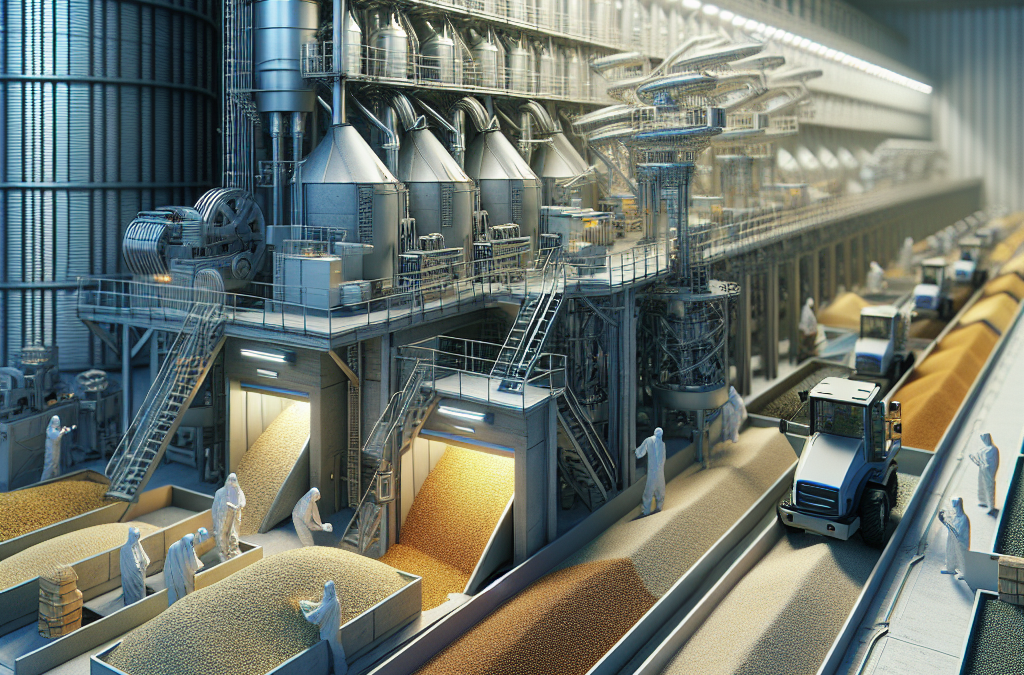Understanding the Importance of Oxygen-Free Storage
Why Oxygen-Free Matters
Let me tell you, the role of oxygen in the storage of grains is a big deal. It’s like that unwanted guest who just won’t leave; it catalyzes deterioration and various degrading processes. When I first started storing grains, I learned that oxygen can lead to oxidation, spoilage, and even mold growth. This is why creating an oxygen-free environment is crucial to prolonging shelf life.
The greatest enemy to our grains is the microbes and pests that thrive with oxygen present. In my journey of mastering grain storage, switching to oxygen-free environments was a game-changer. To maintain quality and ensure nutritional value, keeping grains in a space without oxygen is essential.
So, if you want your grains to stay fresh longer, oxygen-free storage is the way to go. It’s all about preserving the integrity of the grain and avoiding those pesky problems that could otherwise ruin them.
Historical Perspective on Grain Storage
You may not realize it, but humans have been battling the effects of oxygen on grains for centuries. Ancient civilizations had their unique ways of storing grains—think clay pots or underground silos. As I dug deeper into this subject, I found that even before our modern techniques, there was a stark realization about how oxygen impacts stored grains.
Fast forward to today, our understanding of chemistry and biology has paved the way for advanced storage technologies. It’s fascinating to think how far we’ve come! From simply burying grains to using sophisticated vacuum sealing methods, each step has made a impact on preserving grains better.
Keeping this historical context in mind enriches my appreciation for modern grain storage techniques. We’re riding on waves of know-how that our ancestors laid down for us—pretty cool, right?
The Science Behind Oxygen Exclusion
It’s not all just common sense; there’s science backing the oxygen-free storage. To get a bit nerdy here, when oxygen levels are reduced, the biochemical processes in grains become stunted. This means that enzymes that cause decay and spoilage are also slowed down, leading to happier grains!
I remember the first time I tried vacuum sealing my grains. I was honestly a bit nervous, thinking I was going to mess it up. But once I got the hang of it, I saw the stark difference in quality over time. Less oxygen equaled less chance of spoilage—it was practically magic!
Using techniques such as nitrogen flushing or vacuum sealing minimizes the risk of oxidation. It’s pretty crucial for ensuring that the grains not only remain edible but maintain their flavor and nutritional content for as long as possible.
Techniques for Achieving Oxygen-Free Storage
Vacuum Sealing
Vacuum sealing was my first introduction to the world of oxygen-free grain storage, and let me tell you, it’s a total game changer! The idea is simple: remove air from the packaging, which means less oxygen, which results in longer storage life. I remember my first grain-sealing session—I was a bit overwhelmed but excited!
You just pop your grains into a vacuum bag, use a vacuum sealer to suck out all the air, seal it up, and boom! You’re set. I’ve kept grains this way for a couple of years without any noticeable quality loss—pretty impressive, don’t you think?
Oftentimes, people overlook this technique, thinking it’s too complicated or not needed. But trust me, if you’ve got a little vacuum sealer, you can do it in minutes. Plus, it makes things organized and neat, something I definitely appreciate!
Nitrogen Flushing
Another technique I stumbled upon is nitrogen flushing, and honestly, it feels like I’m a scientist in my kitchen whenever I use this method. By replacing oxygen with nitrogen, you create an atmosphere where grains are less likely to decay. This is especially useful for larger quantities of grains.
The first time I attempted it, I felt like a mad scientist. I just used a nitrogen gas tank to fill the storage container with nitrogen before sealing it. It’s a straightforward process, but the peace of mind knowing that my grains would last much longer was just priceless.
Nitrogen flushing isn’t just for the pros; anyone can do it with the right equipment. And once I saw how well it worked, I knew it was worth the investment for my grain storage needs!
Controlled Atmosphere Storage
Then we have controlled atmosphere storage, which sounds all high-tech and fancy. But let me break it down for you: this technique involves creating a specific environment that regulates oxygen and carbon dioxide levels. I had my first experience with this in a commercial setup, and it was eye-opening, to say the least.
Get Whole Wheat Flour, Grains and Milling Supplies – CLICK HERE
This controlled environment basically helps to prolong the life of stored grains by ensuring no harmful gases are present. It may be more of an investment than the other methods, but when you’re talking about large grain storage, the long-term benefits are absolutely worth it!
As I learned about controlled atmosphere storage, I knew that it would be a go-to option if my grain storage expanded into larger quantities. Just imagine being able to store grains for months without worrying—seriously, what’s not to love?
Benefits of Storing Grains in Oxygen-Free Environments
Prolonged Shelf Life
One of the first benefits I noticed when I switched to oxygen-free storage was the prolonged shelf life of my grains. It was astonishing to see how much longer my grains lasted compared to when I just tossed them in a jar and hoped for the best. I once had a batch of wheat that went on for years in an oxygen-free environment!
The longer shelf life translates to less waste, so for the eco-conscious folks out there, this method is a win-win. You’re not only saving your grains, but you’re also doing a solid for the planet by reducing food waste. It makes the whole process feel even more rewarding!
Ultimately, understanding that I can store my grains longer without worrying about spoilage allows me to stock up on my favorite grains without the hassle of constant re-purchasing. This means I can save money and time. Win-win again!
Maintained Nutritional Value
It’s not just about the shelf life; the nutritional value of stored grains often takes a hit when oxygen is present. When I started storing grains oxygen-free, I was thrilled to learn about how these methods preserved essential nutrients. It’s humbling to consider how something as simple as removing oxygen can make such a huge difference.
Grains are an important part of our diet, and knowing that I can maintain their health benefits is incredibly satisfying. I’ve noticed that the more I care for my grains, the more they care for me back, nutritionally speaking.
By investing a bit of time into proper storage, I can ensure that my grains retain as much of their nutritional goodness as possible—definitely something worth celebrating!
The Economic Advantage
Finally, let’s talk money. Managing your grain properly in an oxygen-free environment ultimately leads to economic benefits. Reduced spoilage and longer shelf lives mean fewer trips to the store and, therefore, lower ongoing costs. Trust me, I love saving a buck!
The initial investment in tools like vacuum sealers or nitrogen storage systems can pay off in the long run. I found that not only do I save on purchasing new grains frequently, but I can also buy in bulk and take advantage of sales!
Ultimately, by focusing on oxygen-free storage techniques, you not only preserve quality and nutrition but also improve your budget. It’s all about working smarter, not harder. And who doesn’t want to save a bit of cash while enjoying quality grains?
Frequently Asked Questions
1. What is the primary benefit of storing grains in oxygen-free environments?
The primary benefit is the prolonged shelf life of the grains. By eliminating oxygen, you significantly reduce the risk of spoilage and decay.
2. How does vacuum sealing work for grain storage?
Vacuum sealing works by removing air (and therefore oxygen) from the packaging. This helps preserve the grains for a much longer term and keeps them fresh.
3. Is nitrogen flushing safe for home use?
Yes, nitrogen flushing can be safe when done correctly. It simply displaces oxygen to protect your grains, making it an effective method for preserving food.
4. Can I use these methods for all types of grains?
Most grains can benefit from oxygen-free storage methods, including rice, wheat, and quinoa. However, always check specific guidelines for unique grain types.
5. What should I do if I notice signs of spoilage in stored grains?
If you see signs of spoilage, it’s best to discard the affected grains and assess your storage practices. It might be time to upgrade your methods to better preserve future batches.
Get Whole Wheat Flour, Grains and Milling Supplies – CLICK HERE
Related Content
- The Ultimate Guide to the Best airtight containers for grain storage in 2025
- The Ultimate 2025 Guide to Home Food Storage and Preservation Strategies
- Real Emergency Directions – Your RED book
- How to Store Grains and Wheat
- The Ultimate Guide to Storing Flour with Oxygen Absorbers in 2025: 7 Effective Strategies
Auto Amazon Links: No products found.





